Your team is a blend of street-smart growth marketers and salespeople. They drive leads and close deals.
Everything is working fine—until the moment you’re ready to scale.
Now you’re hitting a wall. Data is both scattered and siloed, and it’s preventing you from making informed decisions.
Should you add headcount? Hire a marketing analyst?
The short answer is no. You need a GTM engineer on your team.
What is a GTM Engineer? (Role and Impact)
Go-to-market (GTM) engineers combine technical and analytical skills, business acumen, and a deep understanding of sales and marketing strategies. Their goal is to orchestrate marketing tech, sales automation, AI tools, and analytics into a coherent system that delivers quality leads for the best possible customer acquisition cost (CAC).
In other words, a GTM engineer builds and optimizes end-to-end revenue pipelines. They might, for example, configure a chatbot to engage website visitors without human intervention, set up an AI to personalize outbound emails at scale, and script a workflow that hands hot leads from marketing to sales in real time. And that’s just the to-do list for Monday.
Why GTM Engineers Matter for Startups and RevOps
Traditional RevOps roles have a tendency to stay in their trenches—CRM management, SDR hiring, and setting up lead nurturing tools. The GTM engineer goes further and architects the entire revenue tech stack and the automation that runs on top of it.
How does this look in practice?
Before the AI boom, growing revenue teams would hire more SDRs and BDRs to prospect leads through platforms like LinkedIn Sales Navigator and ZoomInfo. A single GTM engineer, in contrast, can replace a whole team of reps through outbound automation.
Reddit users claim that one savvy GTM engineer can replace even 5 to 7 SDRs:

Likewise, mature, enterprise-level RevOps teams often use dozens, if not hundreds, of marketing and sales tools without understanding all their features. It’s a plain waste of money that adds up to friction and siloed data.
Want to add insult to injury? Gartner revealed that only 33% of martech stacks are actually used. A GTM engineer steps in to consolidate and streamline that dusty old tech stack.
Key Responsibilities and Skill Set
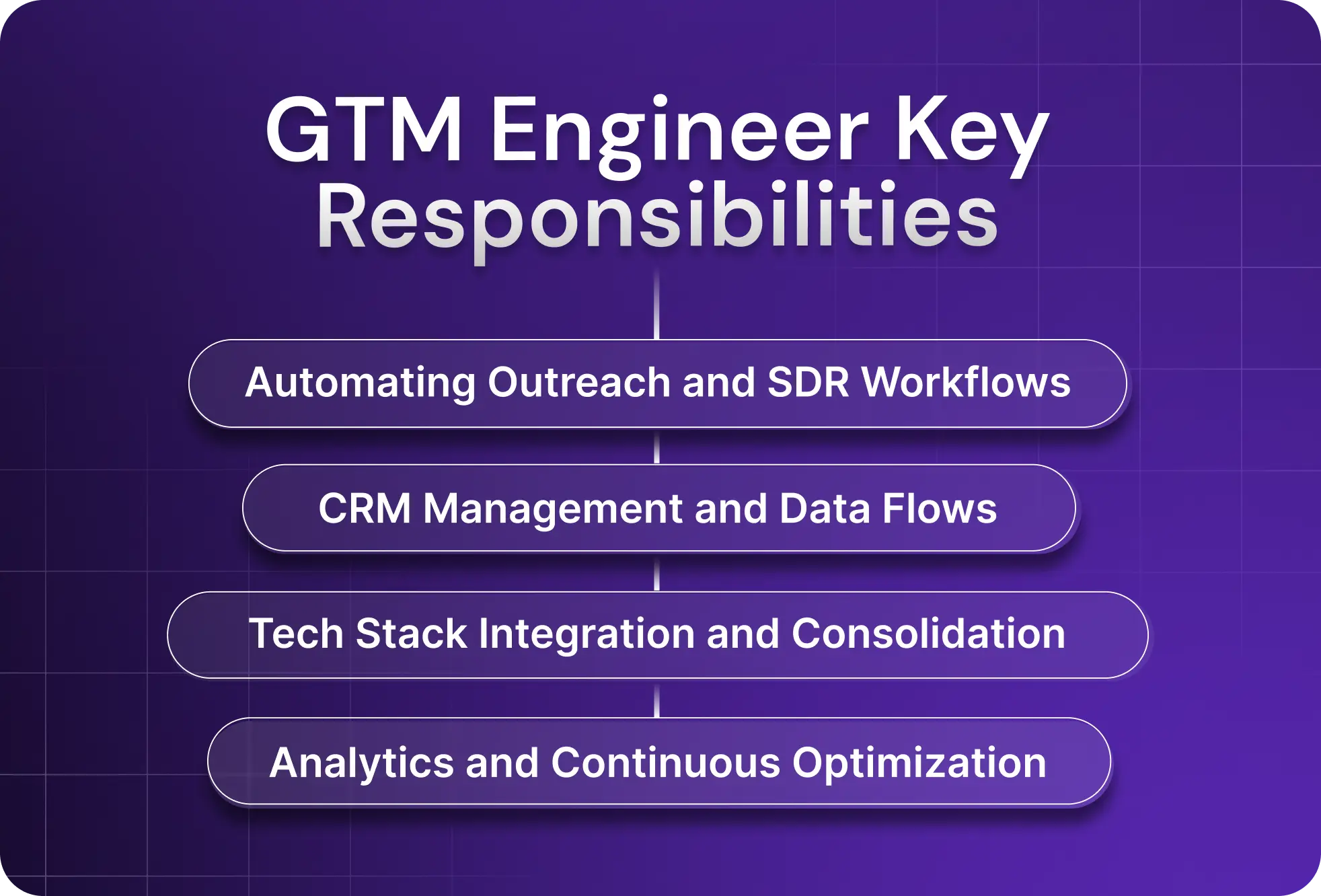
At a high level, the GTM engineer is responsible for designing, building, and managing the automated workflows that drive revenue.
Let’s get more granular and look at these responsibilities in detail.
Automating Outreach and SDR Workflows
Build and manage multi-channel sequences, such as LinkedIn → email → cold call → SMS (often powered by AI BDRs).
Design trigger-based cadences, such as new lead → enrich with data → score for a fit → enroll in lead nurturing sequence → route to an SDR.
Automate marketing and sales follow-ups triggered by predefined actions to ensure no lead falls through the cracks.
Configure and monitor AI sales assistant tools. Artisan’s AI BDR Ava, for example, prospects from enriched databases (300M+ contacts), personalizes emails using firmographics and buyer intent, and hands off hot leads to account executives (among many other features).
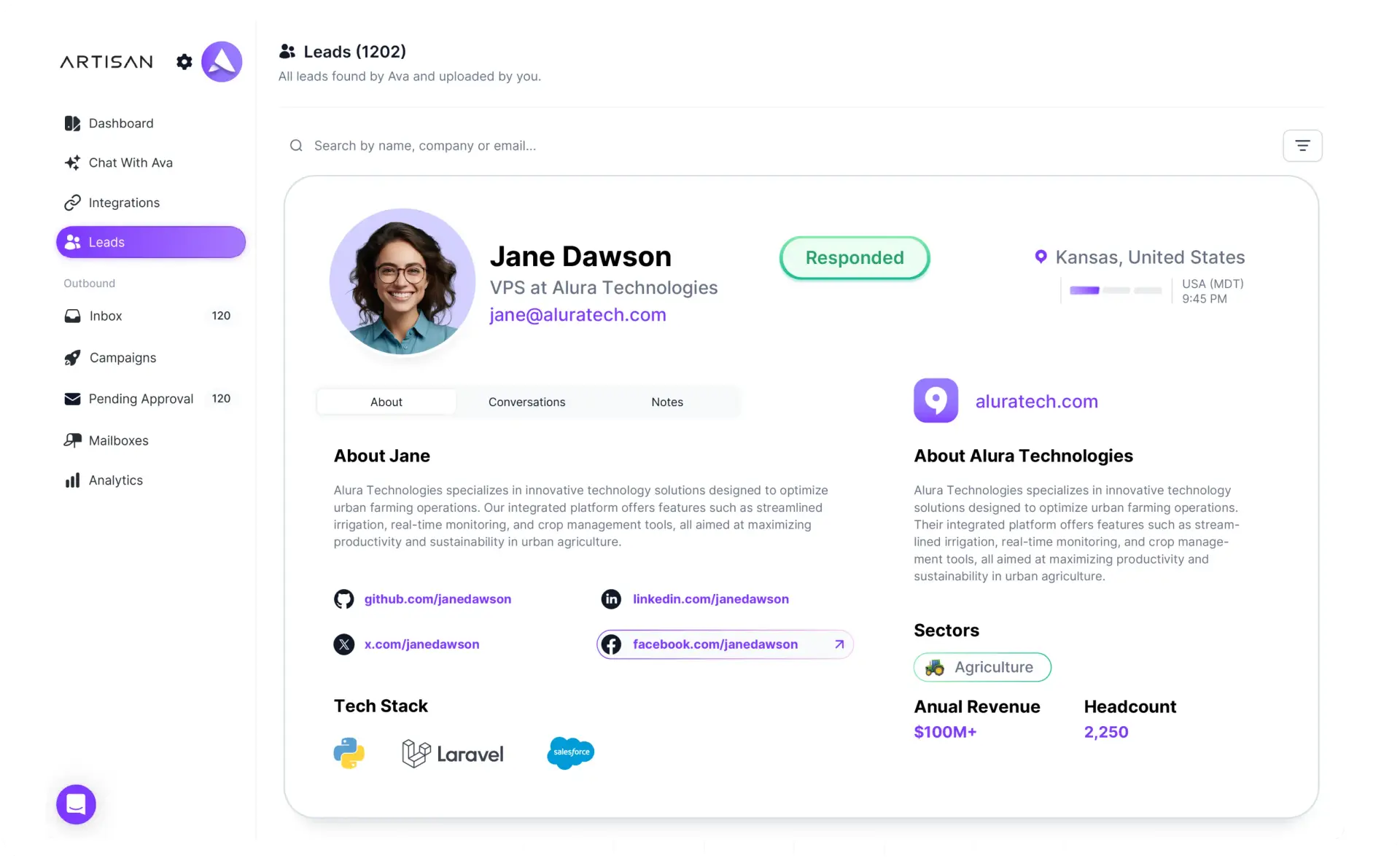
CRM Management and Data Flows
Maintain the company’s CRM (Salesforce, HubSpot, Pipedrive) as the single source of truth.
“The CRM is where every signal, conversation, and conversion lives. Without it as the single source of truth, our GTM engine would just be a tangle of disconnected tools. Make it the heartbeat of your GTM workflow and everything else will flow from there.” Tina Sang, Growth Lead at Artisan
Set up workflows to auto-populate fields via APIs and no-code tools like Zapier and Tray.io.
Create real-time data pipelines using enrichment tools (Clearbit, Crunchbase), lead scoring models, and behavior tracking.
Perform regular CRM hygiene audits:
Merge duplicate profiles
Update stale records
Standardize field formats
Monitor and fix automation errors
Check custom validations (troubleshooting if needed)
Implement governance rules for consistent data quality across sales and marketing.
Here’s a practical example of a CRM management data flow:
Initial prospecting: A new lead comes in → automatic enrichment via Clearbit or Crunchbase API → CRM is updated with fresh firmographics → appropriate campaign is triggered.
Marketing to sales handover: Lead engagement (email clicks, URL visits, attended webinars) is logged → lead data is fed into scoring models → sales team is alerted to the presence of high-intent leads.
Tech Stack Integration and Consolidation
Map out the full GTM tech stack and integrate it into one workflow: CRM, sales engagement tools, enrichment data providers, analytics, LinkedIn Navigator, email platforms, etc.
Use middleware (Zapier, Make, Workato), native integrations, and custom API scripts or unified platforms to sync data and reduce context-switching (so-called tool fatigue) and replace redundant tools.
Continuously evaluate and integrate new automation solutions if they can simplify workflows or replace manual steps.
Cut SaaS spend and vendor complexity.
Most reps agree that sales has a tech stack problem—66% of sales teams say they’re overwhelmed by the number of tools they have to juggle. On average, 10 tools are involved in closing a deal. The GTM engineer reduces costs and frees up salespeople’s time by integrating and cutting the fat from these unwieldy stacks.
Analytics and Continuous Optimization
Track key metrics across the sales funnel:
Open rates, reply rates, and demo conversion rates
Funnel drop-off points and overall pipeline velocity
Cost per lead (CPL) and CAC
Refine targeting criteria and buyer personas.
Run A/B tests across key outreach variables:
Subject lines
Send times
Personalization in messaging
Sequence structure
Set up dashboards for real-time campaign performance
Identify which campaigns are meeting expectations and which are underperforming:
Pause underperforming campaigns
Double down on high-performing campaign:
Report on automation ROI:
Time saved
Lift in leads and conversions
Revenue impact
Headcount savings
Retention and churn rates

How to Build Your GTM Tech Stack and Workflows
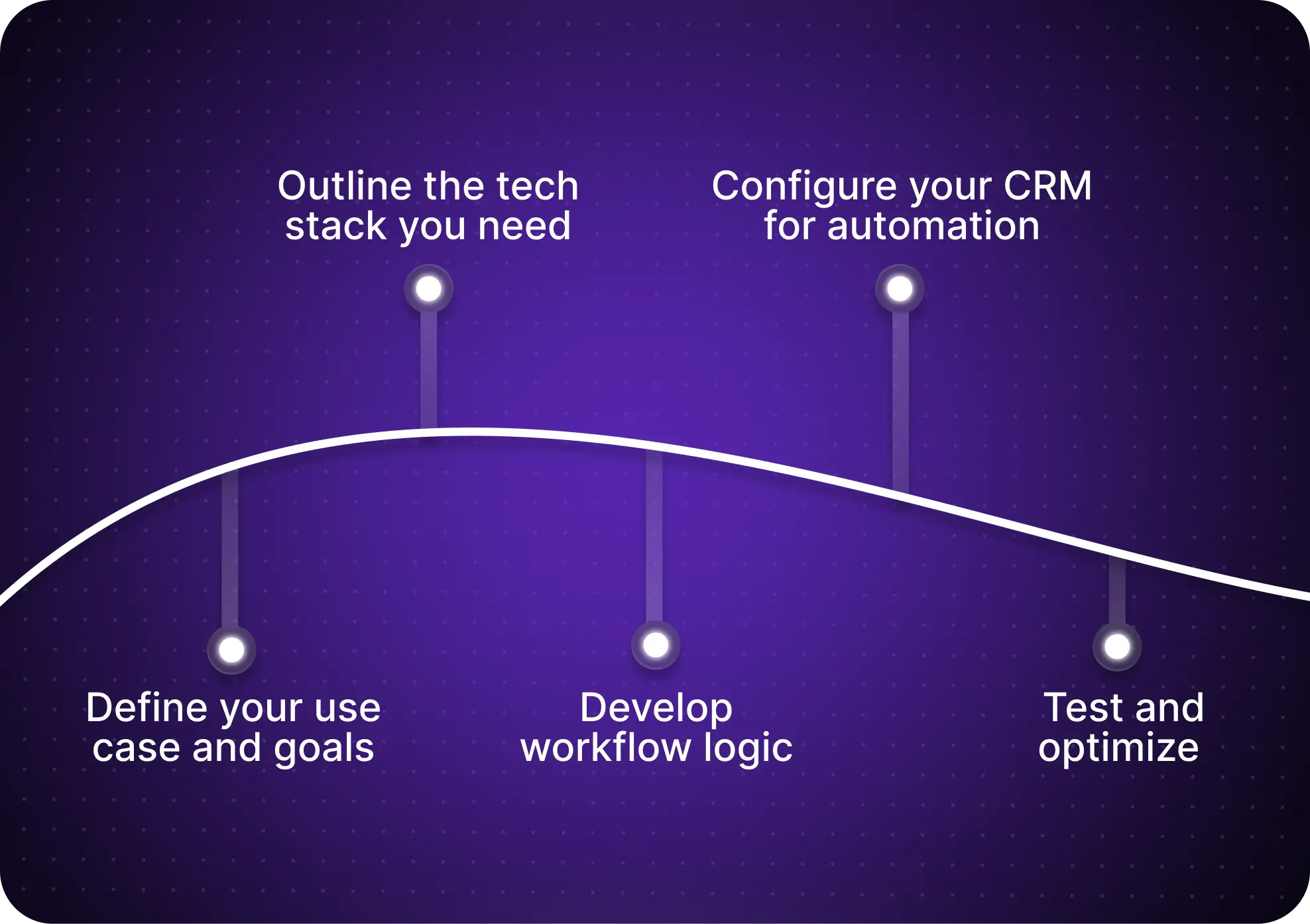
In this section, we’ll walk you through the process of setting up a GTM tech stack, with sample workflows as examples.
1. Establish Your CRM as the Foundation
Your CRM (Salesforce, HubSpot, etc.) is the engine of GTM execution. Configuring it and defining clear automation logic are the first steps in setting up a GTM workflow.
1. Automate common lead management tasks.
Leads entering your CRM should be enriched and scored automatically. They are then routed directly to sales or added to a nurturing campaign.
Examples of lead management automation:
New lead enters → auto-enrich → assign owner → trigger sequence.
Deal stage changes → notify team → schedule task or sequence handoff.
2. Integrate with enrichment tools (e.g., Artisan’s Ava, Clearbit, Crunchbase)
Enrichment tools are foundational to accurate scoring. They pull real-time firmographics, technographics, and buyer intent. They then score leads using tailored lead scoring frameworks before entering them into cadences.
Set rules to update and lead, contact, and account records and route them automatically based on engagement behavior, buyer persona alignment, and lead score thresholds.
3. Maintain clear logic for handoffs using lead scoring.
Lead scoring is essential because it helps prioritize high-intent prospects and shorten sales cycles. Sales reps and account executives get notified and tasked with contacting those accounts immediately.
And if a prospect doesn’t show buying signals, they will be routed to lead nurturing. Low-scoring leads can be gradually warmed with relevant content until they’re sales-ready.
Here is a sample lead scoring framework:
Lead nurturing sequence if lead score is < 50
From marketing to SDR if the score is 50–79
From SDR to AE if the lead score is ≥ 80
From AE to customer success, if the deal is closed-won and the account enters onboarding
And here is an example of rules-based sequence enrollment:
If SDR-assigned → Enroll in 10-step follow-up sequence
If AE-assigned → Trigger calendar invite email and call preparation task
If the company is in the customer list → route to the customer service manager and trigger an upsell sequence
2. Set Up Multi-Channel Cadences
Once lead management workflows are in place, it’s time to automate the processes that help marketing and sales identify, reach, and convert prospects.
GTM engineers will typically outline a multi-touch sequence that combines LinkedIn, email, and sometimes calls or voicemail as part of a proven outbound sales strategy.
This involves a three-step process:
Outline tech stack requirements
Define workflow logic
Direct leads based on response
Let’s look at an example of how this might work in practice.
Say you have to target VPs of Marketing at SaaS companies with $5M–$50M ARR who recently posted about hiring, growth in revenue, or scaling their efforts (an intent signal).
Your tech stack might look like the following:
Lead sourcing and enrichment: Clay, Artisan, LinkedIn Sales Navigator (or another AI prospecting tools)
Outreach and automation: Artisan or Outreach.io
CRM sync and trigger logic: Zapier, HubSpot Workflows, or Salesforce Flows
AI enrichment: Artisan’s Ava or Clearbit
Phone calling: Aircall, Orum, or native dialer
Here’s an example of a GTM-engineered workflow targeting VPs of marketing:
At all stages throughout the process, engaged leads are automatically removed from further automation once they reply or book a meeting via a simple automation like Zapier → CRM tag update → exit workflow.
Day 1: LinkedIn connection request
Trigger: New enriched lead enters a “SaaS VPs That Are Hiring” ICP list.
Action: If not connected → send a connection request with a personalized note.
Day 3: Warm email #1 (pain point hook)
Trigger: Connection accepted OR no response within 48 hours.
Action in Artisan: Send the first email—a warm, personalized email referencing a pain point.
Day 5: LinkedIn InMail or DM follow-up
Trigger: No email response within 48 hours.
Action: If no response, send a LinkedIn InMail or direct message, sharing a short industry insight or asking a question.
Day 7: Email #2 (value-add resource)
Trigger: No reply to first email, and LinkedIn step complete.
Action: Send a second email with a value-add resource like a case study or relevant report to build credibility.
Day 10: Follow-up call or voicemail
Trigger: Still no response, but the contact has a phone number.
Action: Auto-task generated in HubSpot for SDR to call via Aircall, Orum, or native dialer.
Day 11: No response
If there’s no success but the lead is important, they’re moved to a lead nurturing sequence or sent relevant case studies in one month. Alternatively, HubSpot is set to enrich the lead record with new data within one month.
3. Implement a Testing and Automation Framework
A GTM engineer not only designs workflows but is also responsible for ongoing testing and refining. To paint a complete picture and compare results, they develop automated dashboards or reports.
In cold outreach, for example, they might set up control groups for the “old” method and A/B tests.
Here’s what your testing framework might look like:
1. Set up analytics tools
Use tools like Artisan dashboards, HubSpot reports, and Looker Studio to track:
Email open, click, and reply rates
Pipeline velocity and conversion rates
Segment-specific results, organised by ICP, campaign, rep, and channel.
GTM engineers will typically organize this data into a weekly or monthly report to share with RevOps and other stakeholders.
2. A/B test across campaigns
Testing isn’t just for subject lines. GTM engineers run experiments across the entire funnel to identify winning tactics.
Here are some real-world examples across different funnel stages:
CTAs: “Book a demo” vs. “See it in action.”
LinkedIn connection tactics: “Direct pitch in the intro” vs. “Personal hook with no CTA,” and direct message vs. InMail.
AI personalization level: “Short message with only firmographic personalization” vs. “Deep personalization using recent funding news.”
CRM workflow automation: “Auto-assign all demo leads to the SDR queue” vs. “Route high-score leads to AE immediately and bypass qualification.”
3. Document Learnings in the GTM Playbook
Finally, GTM engineers document their insights into a GTM playbook for future use.
In practice, you will capture test results, optimization changes, and learnings in the same way for all campaigns.
Your GTM playbook will record the following:
What was tested
What won/failed
When to apply it (e.g., ICPs, channels)
Copy/paste templates
Collaboration: How GTM Engineers Work With RevOps
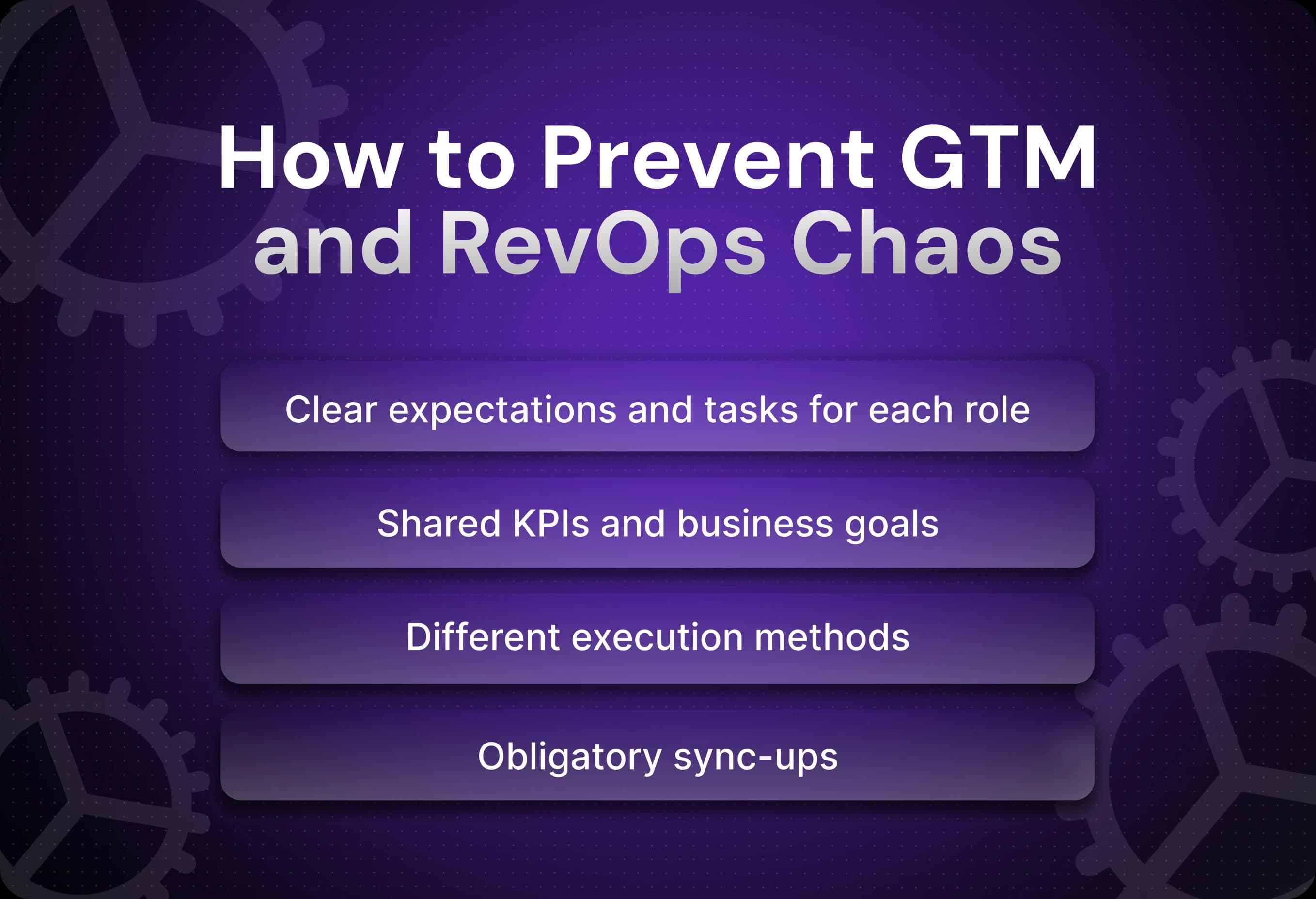
When you’re hiring a GTM engineer alongside your RevOps team, there’s a lot of scope for confusion.
Are they replacing RevOps? Duplicating efforts? Assisting?
Fortunately, a few simple steps are enough to avoid any mix-ups.
Role Distinction and Synergy
Set up clear expectations and tasks for each role to prevent duplication and chaos.
For RevOps, the focus should be on process standardization, reporting, enablement, and governance. GTM engineers, on the other hand, focus on rapid experimentation, playbook creation, tool verification and integrations, and scaling.
For example, RevOps sets lead routing rules, and the GTM engineer implements real-time automation.
Shared KPIs and Dashboards
Both roles work toward shared KPIs and business goals but apply different means to reach them.
Let’s picture a typical sales scenario where conversion rates from MQL to SQL are low. RevOps steps in and ensures the definition of MQL is right, and the GTM engineer deploys better lead nurturing sequences to improve that conversion.
Here are the core shared metrics in this example:
Pipeline velocity
Lead-to-opportunity conversion
CAC and ROI of GTM initiatives
Sales cycle length
Retention/churn rates
The volume of leads at each stage
Average days in stage
Avoiding Silos and Duplication
When two camps work on the same goals, duplication can creep in.
How to avoid it? Set up weekly or biweekly sync-ups, where a GTM engineer and the RevOps team can demo new solutions, identify bottlenecks, and map out a unified path to fix them.
They’re not competing, they're complementing each other—and your goal is to get this point across.
How Artisan Supports GTM Engineers
Agentic AI is changing the way that GTM engineers work. It’s allowing for deeper, more expansive automations and a level of scale that simply wasn’t possible before. AI platforms are fast becoming an indispensable part of the GTM tech stack.
Consolidated Platform (Say Goodbye to Dozens of Tools)
Artisan is a cold outreach platform powered by an AI agent called Ava. She automates 80% of outbound tasks.
Specifically, Artisan merges CRM, outreach, enrichment, and analytics into one unified UI, avoiding integration headaches.
You can use native or script custom triggers to push and pull data through your CRM, configure custom analytics dashboards, and automatically update lead records in accordance with outreach stages.
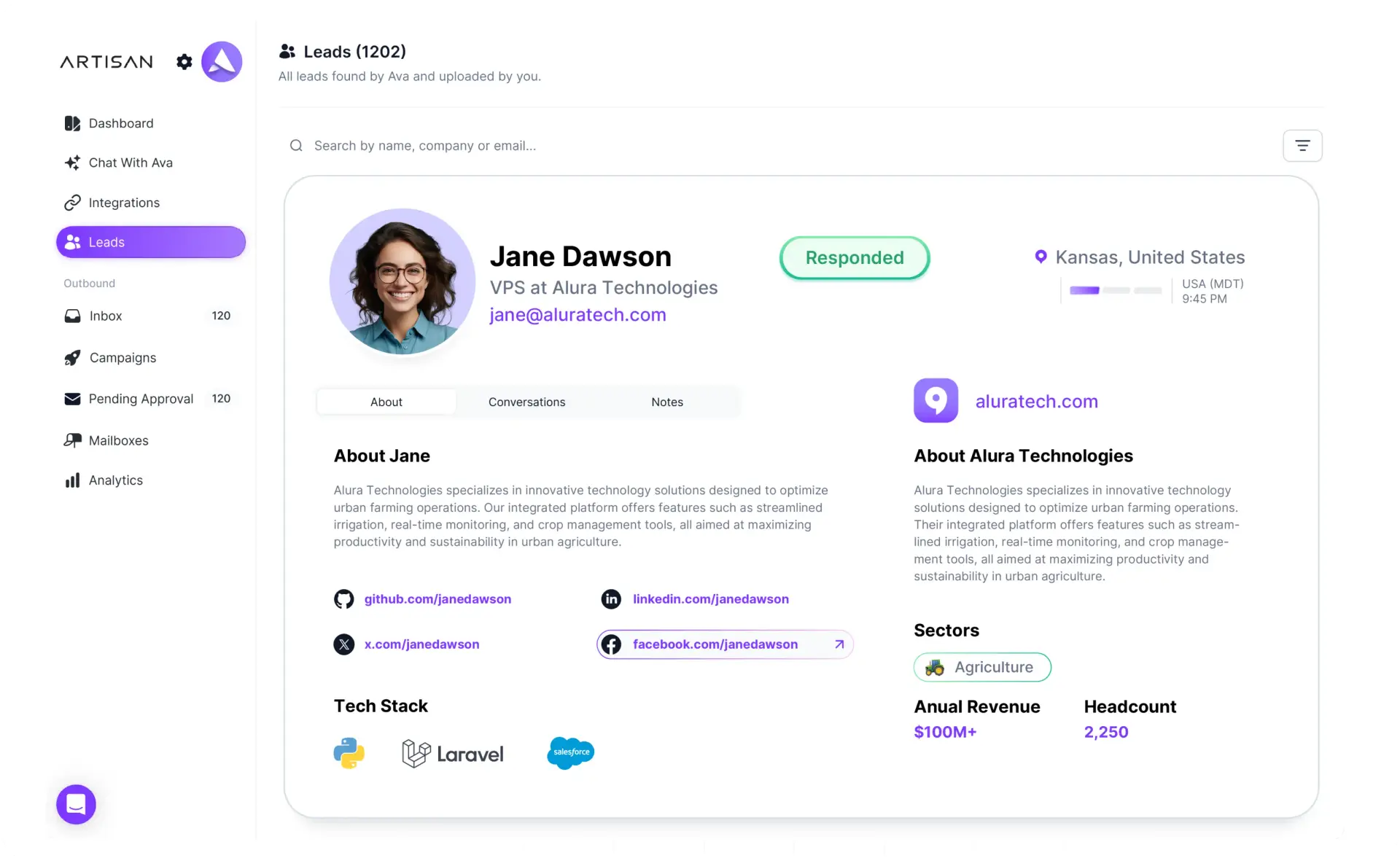
AI-Powered SDR (Ava)
What makes Artisan truly indispensable in a GTM engineer tech stack is AI BDR Ava. She automates and supports lead generation at scale, with no human intervention needed.
For lead discovery, you simply feed Ava with a detailed description of your buyer personas along with your offerings, website, pain points, and proof points. Then, Ava runs deep research and populates a perfect-fit lead list with validated accounts.
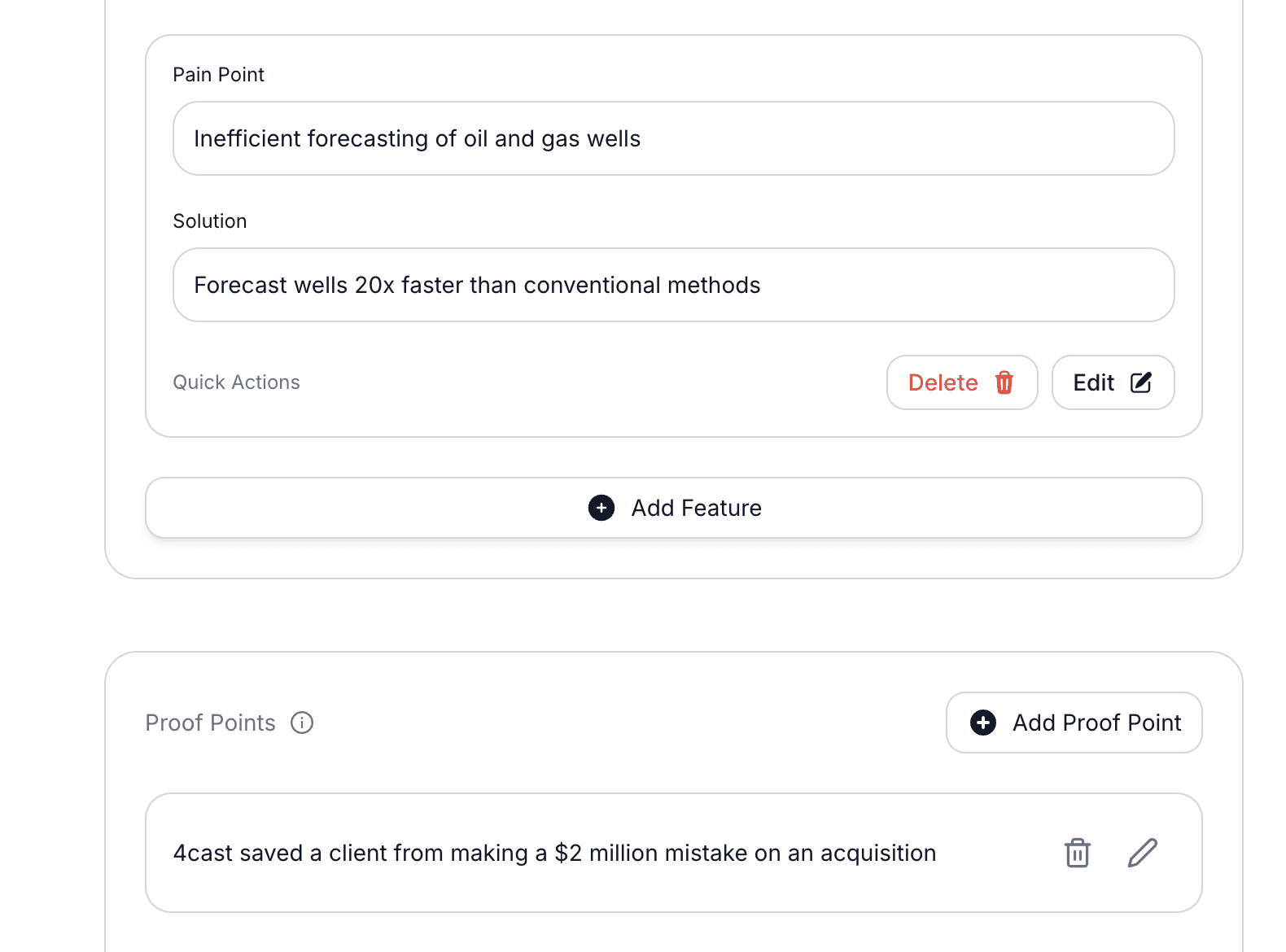
Artisan’s research engine goes even further and gathers recent intent data for every lead from hundreds of sources. Data refreshes occur daily, ensuring that you can confirm with 100% certainty that a lead is showing buying interest.
“When a prospect visits a user's website, AI BDR Ava auto‑enriches their contact details, determines qualification status, and, if qualified, triggers a personalized outbound sequence. All of this is done without a human lifting a finger. Why is this important? Because GTM is about responding to buyer signals instantly, while interest is highest.” Tina Sang, Growth Lead at Artisan
Another cool feature for GTM engineers aiming to keep their pipeline enriched with fresh data is Artisan’s option to choose a lead source.
Artisan has three databases:
B2B with over 100M verified contacts
Local data with over 200M local Google Maps businesses
E-commerce with over 12M stores
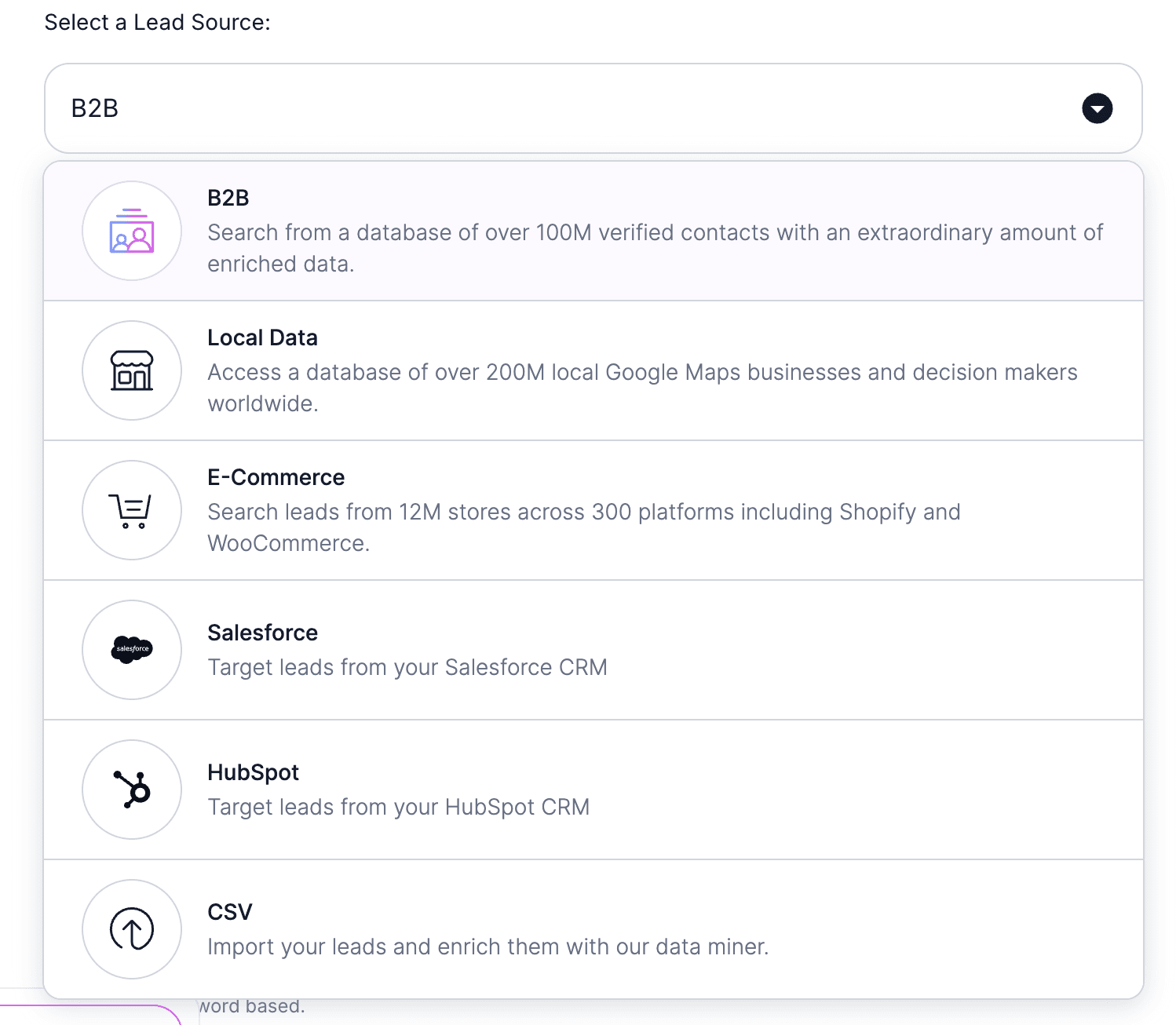
No-Code Workflow Builder
Artisan has also developed drag-and-drop builders to set up multi-step email alongside complex trigger workflows. Variables include new lead, status change, add to sequence, update CRM, alert team, and more.
Real-Time Analytics and Optimization
Artisan provides full-picture monitoring of all outbound campaigns, with AI insights for optimizing low-performing sequences, messaging, and lead pools.
Artisan’s dashboard includes:
Open rates
Reply rates
Pipeline impact
A/B testing results
Top conversation drivers
Social media analytics
ICP performance
Personalization performance
Artisan also continuously takes measures to boost your deliverability and cold email response rates by optimizing send times, adjusting send volumes, and managing your email account health.
Launch Sequence: Activate Your GTM Power
In an era of AI and automation, it’s imperative to invest in the talent and sales tools that empower GTM engineers. The role is here to stay, so you either adapt or get left behind.
Change your mindset from hiring more headcount to scale to finding tools and designing new workflows that help RevOps, marketing, and sales teams do more with less.
With Artisan, you can automate 80% of a BDR’s jobs at a level that matches—and even exceeds—human inputs. You can scale your outbound at a fraction of the usual cost and in significantly less time.


